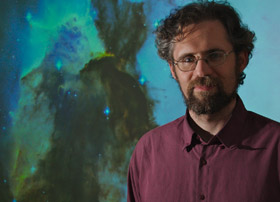
Dr. D. Barry McKernan, an assistant astronomy professor at BMCC, is the lead author of a new paper that presents unprecedented observational confirmation of how some of the largest black holes consume matter. The results are based on data collected using NASA’s Chandra X-ray telescope, which can detect extremely hot material swirling into black holes. The conclusion, says, McKernan, is that black holes ‘are very messy eaters.”
Black Holes
Black holes are extremely compact objects that have a gravitational field so strong that nothing, not even light, can escape. The largest black holes, called supermassive black holes, contain as much mass as a million to a hundred million Suns and sit at the centers of galaxies. McKernan’s two-year study of these supermassive black holes reveals their immediate environment to be extremely turbulent, with significant amounts of material being kicked away from the black hole before it gets close enough to be swallowed.
The paper appeared in the August 2007 issue of Monthly Notices of the
Royal Astronomical Society, and was co-authored by Tahir Yaqoob of John
Hopkins University and Christopher Reynolds of the University of Maryland.
BMCC is the only community college represented in the study.
The study used the Chandra X-ray telescope, which is one of NASA’s
orbiting Great Observatories and in the same family of missions as the
Hubble Space Telescope.
Black Holes are Like the “Cookie Monster”
In describing the erratic way a black hole absorbs matter, McKernan said,
“It’s not unlike the way the Cookie Monster tries to eat a cookie on
Sesame Street. Most of the crumbs actually go flying out of his mouth,
and very little of the cookie appears to be devoured. In the same way,
these big black holes draw a lot of material towards them, but then seem
to send a lot of that flying off. By comparison, relatively little
material appears to be actually devoured.”
McKernan said that while astronomers have theorized for a long time that
matter close to feeding black holes is distributed this way, they have
never had such detailed and impressive confirmation of these ideas. Being
able to actually see this activity-made possible through the highly
sensitive equipment aboard the Chandra telescope-is “very exciting,” said
McKernan.
McKernan and his team detected the spectral fingerprints of outflows close
to the black hole. By figuring out the amount of X-rays absorbed by the
outflows, they could estimate the amount of material being carried away
from the black hole. It turned out the outflows can carry far more
material away from the black hole than actually gets swallowed.
New Data, More Complex Models
The new data presented in the paper will help astronomers develop more
complex models of the way black holes distribute matter. McKernan said
“the next step lies in understanding why black holes are quite thismessy
and where all the mess goes. Does it escape the black hole neighborhood?
Or does it get pulled back inwards to be chewed up again?”
About Professor McKernan
McKernan, who is beginning his second year teaching Introductory Astronomy
at BMCC, is also an associate at the Hayden Planetarium, at the American
Museum of Natural History, which he credits for supporting the handful of
CUNY astronomy professors. He also notes that the research would not have
been possible were it not for a recent agreement between CUNY and the
faculty union (PSC-CUNY), that provides release time for untenured professors.
“Having the freedom to be involved in this level of research will be
enormously beneficial to the entire CUNY academic community,” said
McKernan. “CUNY science faculty will have greater opportunities to make
significant contributions to our fields, and we can strengthen CUNY’s
reputation within the wider academic community.”
McKernan feels that his involvement in cutting-edge astronomical
research helps convey to his students some of the excitement and urgency of
actual science.”You can’t help but love this stuff and students pick up on
that very quickly. Pretty soon that’s all a lot of them want to talk about
too! “

